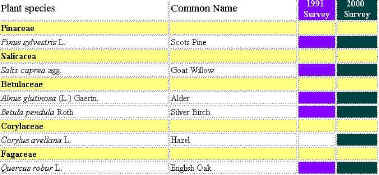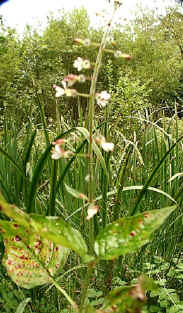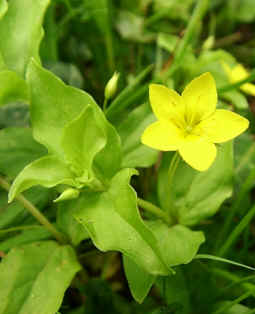Offwell Wetland Survey
Comparison of Species Lists from the Wetland Surveys 1991 and 2000
The 1991 survey had the sole purpose of listing all the plant species which were present in the wetland at that time. It was a walking survey which noted all the different species present over a short period in July. In contrast, the 2000 survey was a full ecological survey carried out in September. It is important to remember that although restoration was finished by 1991, rhododendron clearance actually started in this area in 1988. The Wetland was actually flooded in March 1989 to create a transition from open water to dry land. Therefore by the time of the 1991 survey, there was significant natural regeneration particularly where it was wetter. Prior to the clearance rhododendron dominated. The later timing of the 2000 survey (September rather than July) means that the number of plant species may have been slightly under-recorded. This is due to the fact that the foliage and flowers of early-flowering species may already have died back so that the plants had become unrecognisable. It is important to remember that a species list is merely a record of what species are present at a particular time. It does not give any information on how much of the species is present at the time. One small plant of a species, or an entire stand of a species, covering a substantial area, each give rise to an equal record in the list. 1. Plant species diversity in the wetlands was comparable in 1991 and 2000. The 1991 survey found 92 species of flowering plants, ferns and mosses, while the 2000 survey found 85 species. This is an 8 to 9-fold increase over the number of plant species in the area prior to restoration. This can be inferred from a survey of another area in the Woodland Education Centre similarly dominated by Rhododendron (The Woodland Project). This survey found only 12 plant species
where the Rhododendron grew. Of these, only three species occurred under the rhododendron
canopy. These were all mosses and they were only found in less dense regions, where light
levels were slightly higher. All the other species recorded were tree species which had
managed to struggle above the level of the rhododendron canopy before it completely closed
over. On the death of these trees, there would be no replacement because light levels
under the established canopy are too low to permit seedling development.
3. Differences between the surveys.
|


